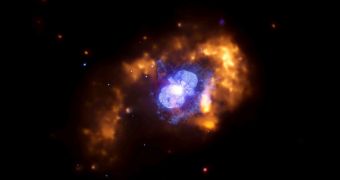Supernovae explosions are some of the most powerful releases of energy in the universe known to man. A possible explosion of the Sun, predicted to occur in about 5 billion years in the future, would most likely destroy all the life on Earth, and possibly the entire solar system. Luckily, until this event would take place, the human race would have evolved enough, so that the technology would enable us to move to a more friendly solar system.
Nevertheless, we are not clear of danger yet, as our galaxy houses more than 200 million stars, amongst which the closest, Proxima Centauri, is situated at only two light years away from our planet, meaning it could take as little as two years before our planet would receive a deadly level of X-ray or gamma-ray radiation, in case such an event ever occurs.
In 1838, a star called Eta Carinae increased its magnitude to that of the currently brightest star on the night sky, the white dwarf Sirius, and maintained it for twenty years before fading away to join the population of faint stars. In the middle of the 20th century, the star brightened up again and has been doing so ever since. A quick analysis of the old star reveals that it might explode into a supernova somewhere in 10,000 to 20,000 years.
Again, the large scale distances of the universe spear us from any evasive actions we would take to save ourselves, as Eta Carinae is situated at a distance of about 7,500 light years away from Earth. Furthermore, the eccentricity of the planet's orbit is about 45 degrees in relation to the spin axis of the star, thus even if the explosion blast reaches our solar system, it would miss Earth. Astronomers argue that, in the case of supernovae explosions that take place at large distances from Earth, much of the blast remnants would be absorbed into the interstellar dust well before they reach our planet.
The Earth is constantly being subjected by huge amounts of radiation, in the form of solar wind; however, most of them are being deflected by the planet's magnetic field, and absorbed into the atmosphere before they reach the surface. Taking into consideration all these facts, the possibility that life on Earth will be wiped by debris from a supernova explosion are extremely remote. Nevertheless, astrophysicists aren't taking any chances and constantly search for other means through which a supernova explosion could pose any threats to Earth.
For example, what if a particular supernova explosion would be one hundred times more brighter than the brightest stellar explosion ever observed? Would that be enough to inflict serious damage? The brightest observed supernova was discovered in November, last year, and SN 2006gy presents similar features to the Eta Carinae star.
A study regarding the effects of such explosions, conducted by Brian Thomas of the Washburn University, revealed that the supernova SN 2006gy released a rather small amount of X-ray radiation in the process, which was diffused through interstellar space. Furthermore, the emitted X-ray radiation carry relatively low amounts of energy and can be successfully absorbed into the atmosphere. He argues that the effects of the light in the optical domain would be more dramatic than previously observed, thus if the Eta Carinae detonates, it will quickly become the most visible object on the night sky, except for the Moon, and may remain so for as long as six months. It could be visible even in daytime conditions!
Long exposure to the blue light radiated by the supernovae could also interfere with some biological functions, such as biological timing to generate an unbalanced endocrine system - mostly associated with the Seasonal Affective Disorder, commonly known as winter depression. The effects of light coming from the dead star would also be minimal, as light intensity would be decreased by over 20 percent because it travels the whole distance from the star to our planet.
The researcher is currently evaluating the effects of a supernova explosion within 100 light years, and he states that the Earth is hit by radiation ejected by a supernova once every 20 million years.

 14 DAY TRIAL //
14 DAY TRIAL //